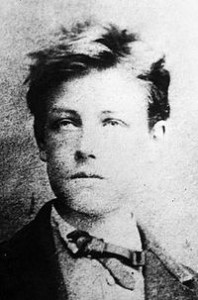 On this day in 1891, poet, Arthur Rimbaud, died in Marseille, France at the age of 37 from bone cancer. Born Jean Nicolas Arthur Rimbaud on 20 October 1854 in Charleville, Ardennes, France. He produced his best known poems in his late teens. Victor Hugo called him the “enfant Shakespeare”. As part of the decadent movement, Rimbaud influenced modern literature, music and art. He had a short and torrid affair with fellow poet Paul Verlaine. Rimbaud never married. He traveled extensively over three continents. His poetry, as well as his life, are said to have influenced writers, musicians and artists including; Pablo Picasso, Dylan Thomas, Vladimir Nabokov, Bob Dylan, Patti Smith and Jim Morrison. My favorite poem of his is Une Saison en Enfer (A Season in Hell) (1873). The French painter Henri Fantin-Latour depicted Rimbaud and Verlaine in his 1872 painting Around the Table (Writers).
On this day in 1891, poet, Arthur Rimbaud, died in Marseille, France at the age of 37 from bone cancer. Born Jean Nicolas Arthur Rimbaud on 20 October 1854 in Charleville, Ardennes, France. He produced his best known poems in his late teens. Victor Hugo called him the “enfant Shakespeare”. As part of the decadent movement, Rimbaud influenced modern literature, music and art. He had a short and torrid affair with fellow poet Paul Verlaine. Rimbaud never married. He traveled extensively over three continents. His poetry, as well as his life, are said to have influenced writers, musicians and artists including; Pablo Picasso, Dylan Thomas, Vladimir Nabokov, Bob Dylan, Patti Smith and Jim Morrison. My favorite poem of his is Une Saison en Enfer (A Season in Hell) (1873). The French painter Henri Fantin-Latour depicted Rimbaud and Verlaine in his 1872 painting Around the Table (Writers).
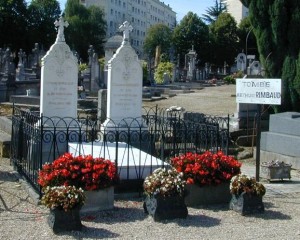 The Final Footprint – Rimbaud is entombed in Charleville-Mezieres Cimetière in Charleville-Mezieres, Champagne-Ardenne Region, France. His tomb is marked by a large upright marble marker. His inscription reads; Priez pour lui (Pray for him).
The Final Footprint – Rimbaud is entombed in Charleville-Mezieres Cimetière in Charleville-Mezieres, Champagne-Ardenne Region, France. His tomb is marked by a large upright marble marker. His inscription reads; Priez pour lui (Pray for him).
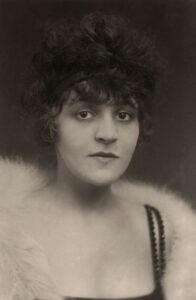 On this day in 1928 dancer, actress, writer, libertine, subject of Otto Dix paintings, Anita Berber died in a Kreuzberg, Berlin hospital, from tuberculosis, aged 29. Born 10 June 1899 in Leipzig.
On this day in 1928 dancer, actress, writer, libertine, subject of Otto Dix paintings, Anita Berber died in a Kreuzberg, Berlin hospital, from tuberculosis, aged 29. Born 10 June 1899 in Leipzig.
Scandalously androgynous, she quickly made a name for herself. She wore heavy dancer’s make-up, which on the black-and-white photos and films of the time came across as jet black lipstick painted across the heart-shaped part of her skinny lips, and charcoaled eyes.[3] Berber’s hair was fashionably cut into a short bob and was frequently bright red, as in 1925 when the German painter Otto Dix painted a portrait of her, titled Portrait of the Dancer Anita Berber.
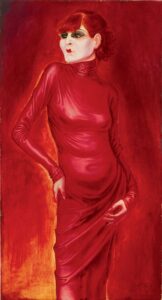 Her dancer, friend and sometime lover Sebastian Droste, who performed in the film Algol (1920), was thin and had black hair with gelled up curls much like sideburns. Neither of them wore much more than lowslung loincloths and Anita occasionally a corsage, placed well below her breasts.
Her dancer, friend and sometime lover Sebastian Droste, who performed in the film Algol (1920), was thin and had black hair with gelled up curls much like sideburns. Neither of them wore much more than lowslung loincloths and Anita occasionally a corsage, placed well below her breasts.
Berber and Droste collaborated on a book titled Dances of Vice, Horror, and Ecstasy in 1923. Around 1,000 copies were published and even prominent artist Hannah Höch owned a copy.
Berber’s dances – which had names such as “Cocaine” and “Morphium” – broke boundaries with their androgyny and total nudity, but it was her public appearances that really challenged social taboos. Berber’s overt drug addiction and bisexuality were matters of public gossip. In addition to her addiction to cocaine, opium and morphine, one of Berber’s favourite forms of inebriation was chloroform and ether mixed in a bowl. This would be stirred with a white rose, the petals of which she would then eat.
Karl Toepfer contends that no one of this era was “more closely associated with nude dancing than Anita Berber”. A contemporary of Berber, choreographer Joe Jencik, described how “The public never appreciated Anita’s artistic expression, only her public transgressions in which she trespassed the untouchable line between the stage and the audience. . . . She sacrificed her person to a self-vivisection of her life.”
Aside from her addiction to narcotic drugs, Berber was also an alcoholic. In 1928, at the age of 29, she suddenly gave up alcohol completely, but died later the same year. According to Mel Gordon, in The Seven Addictions and Five Professions of Anita Berber: Weimar Berlin’s Priestess of Debauchery, she had been diagnosed with severe tuberculosis while performing abroad.
The Final Footprint – After collapsing in Damascus, she returned to Germany and died in a Kreuzberg, Berlin hospital, although rumour had it that she died surrounded by empty morphine syringes. Berber was buried in a pauper’s grave in St. Thomas Cemetery in Neukölln, Berlin
#RIP #OTD in 1994 pianist, jazz singer (Take Five, When I Fall in Love, How Long Has this Been Going On?) Carmen McRae died from a stroke at her home in Beverly Hills, California, at the age of 74. Cremation
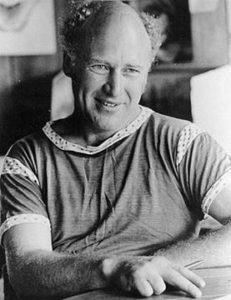 On this day in 2001, novelist, essayist, and countercultural figure Ken Kesey died from complications of liver cancer in Eugene, Oregon, at age 66. Born Kenneth Elton Kesey on September 17, 1935 in La Junta, Colorado. He considered himself a link between the Beat Generation of the 1950s and the hippies of the 1960s.
On this day in 2001, novelist, essayist, and countercultural figure Ken Kesey died from complications of liver cancer in Eugene, Oregon, at age 66. Born Kenneth Elton Kesey on September 17, 1935 in La Junta, Colorado. He considered himself a link between the Beat Generation of the 1950s and the hippies of the 1960s.
Kesey grew up in Springfield, Oregon, graduating from the University of Oregon in 1957. He began writing One Flew Over the Cuckoo’s Nest in 1960 following the completion of a graduate fellowship in creative writing at Stanford University; the novel was an immediate commercial and critical success when published two years later. During this period, Kesey participated in government studies involving hallucinogenic drugs (including mescaline and LSD) to supplement his income.
Following the publication of One Flew Over the Cuckoo’s Nest, he moved to nearby La Honda, California, and began hosting happenings with former colleagues from Stanford, miscellaneous bohemian and literary figures (most notably Neal Cassady), and other friends collectively known as the Merry Pranksters. These parties, known as Acid Tests, integrated the consumption of LSD with multimedia performances. He mentored the Grateful Dead (the de facto “house band” of the Acid Tests) throughout their incipience and continued to exert an influence upon the group throughout their career. Sometimes a Great Notion was a commercial success that polarized critics and readers upon its release in 1964. Kesey regarded the novel as his magnum opus.
In 1965, following an arrest for marijuana possession and subsequent faked suicide, Kesey was imprisoned for five months. Shortly thereafter, he returned home to the Willamette Valley and settled in Pleasant Hill, Oregon, where he maintained a secluded, family-oriented lifestyle for the rest of his life. In addition to teaching at the University of Oregon—an experience that culminated in Caverns (1989), a collaborative novel written by Kesey and his graduate workshop students under the pseudonym of “O.U. Levon”—he continued to regularly contribute fiction and reportage to such publications as Esquire, Rolling Stone, Oui, Running, and The Whole Earth Catalog. Various iterations of these pieces were collected in Kesey’s Garage Sale (1973) and Demon Box (1986).
Between 1974 and 1980, Kesey published six issues of Spit in the Ocean, a literary magazine that featured excerpts from an unfinished novel (Seven Prayers by Grandma Whittier, an account of Kesey’s grandmother’s struggle with Alzheimer’s disease). After a third novel (Sailor Song) was released to lukewarm reviews in 1992, he reunited with the Merry Pranksters and began publishing works on the Internet until ill health (including a stroke) curtailed his activities.
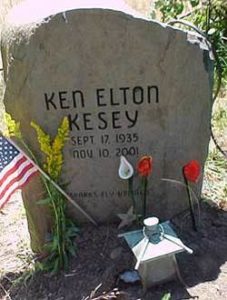 The Final Footprint
The Final Footprint
Kesey is interred in the Kesey Family Farm Cemetery near Eugene.
#RIP #OTD in 2006 actor (Sudden Fear, Shane, Young Guns, City Slickers, Tango and Cash) Jack Palance died at the home of his daughter in Montecito, California, aged 87. Cremation
Have you planned yours yet?
Follow TFF on twitter @RIPTFF


Pingback: For Those Who Dream » TeaWithTater.com